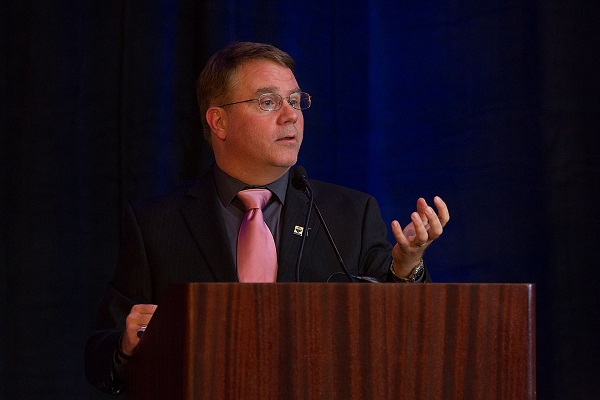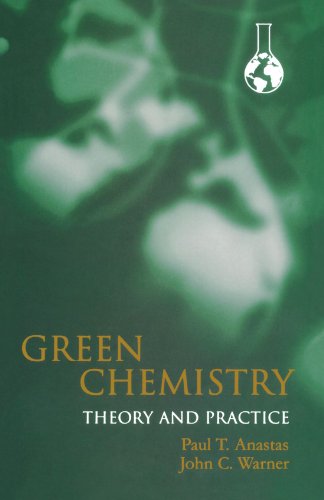John Warner and Green Chemistry
Contributed by Courtney Hastings, Ph.D., Assistant Professor of Chemistry at Loyola University Maryland.
This fall, Loyola will welcome Dr. John Warner to campus as the 2017 Grand Seminar speaker. Dr. Warner is a pioneer in the field of Green Chemistry, and a prolific researcher who has had an enormous impact in a variety of fields. He defined the principles of Green Chemistry in his groundbreaking book Green Chemistry: Theory and Practice, and established the first Ph.D. program in Green Chemistry at UMass Boston. As a fellow researcher in Green Chemistry, I couldn’t be more excited that Dr. Warner is our Grand Seminar speaker this year. In fact, I saw Dr. Warner give a seminar once before when I was a graduate student, and that seminar was a big part of why I ended up doing Green Chemistry research myself. In this blog post, I’d like to explain some of the ideas behind Green Chemistry and John Warner’s vital contributions to this field.

Before we talk about Green Chemistry or Dr. Warner, it might be helpful to talk about the “dark ages” of chemical industry, prior to the establishment of the EPA in the 1970’s. During this time, chemists who were developing a new product would investigate different molecules to find one that performed well and was commercially viable, but would typically ignore safety. So, if a company was developing fire-resistant couch cushions, they would look for a substance that didn’t burn, was comfy to sit on, and was cheap enough to sell profitably. But they probably weren’t doing testing on the safety of long-term exposure to their product. In terms of manufacturing, they needed a process that was reliable and cheap. Companies were not particularly concerned if the manufacturing process produced hazardous byproducts, because there were no laws concerning waste disposal. Often a company would release waste into waterways or bury it in steel drums underground. These irresponsible practices led to a series of public health and ecological catastrophes. These include the effects of products that are harmful to human and ecological health (like DDT and lead paint) and areas ruined by chemical waste from manufacturing (like Love Canal and The Valley of the Drums). Public awareness of these issues led to the establishment of the EPA and passage of numerous environmental laws.
 Amidst efforts to remediate toxic sites and regulate harmful chemicals, a new generation
of scientists wondered if there was a better, safer way to design and manufacture
chemicals. What if products were intentionally designed to be both effective and safe
to use? And instead of cleaning up pollution from chemical manufacturing, would it
be possible to avoid making pollution in the first place? These questions led to the
emergence of Green Chemistry as a scientific field in the 1990’s. A key point for the discipline
came in 1997, when Dr. John Warner, along with co-author Dr. Paul Anastas, wrote the highly influential book Green Chemistry: Theory and Practice. This book outlines a set of twelve principles for improving chemical products and manufacturing, and is a practical “how-to” manual
for preventing pollution in chemical manufacturing. Even now, nearly two decades after
its publication, this book is highly relevant and is a valuable guide for practicing
chemists.
Amidst efforts to remediate toxic sites and regulate harmful chemicals, a new generation
of scientists wondered if there was a better, safer way to design and manufacture
chemicals. What if products were intentionally designed to be both effective and safe
to use? And instead of cleaning up pollution from chemical manufacturing, would it
be possible to avoid making pollution in the first place? These questions led to the
emergence of Green Chemistry as a scientific field in the 1990’s. A key point for the discipline
came in 1997, when Dr. John Warner, along with co-author Dr. Paul Anastas, wrote the highly influential book Green Chemistry: Theory and Practice. This book outlines a set of twelve principles for improving chemical products and manufacturing, and is a practical “how-to” manual
for preventing pollution in chemical manufacturing. Even now, nearly two decades after
its publication, this book is highly relevant and is a valuable guide for practicing
chemists.
So what does Green Chemistry look like in the real world? One of the Principles of Green Chemistry is to design new products with human and ecological safety in mind. One recent example of this principle is a firefighting foam developed by the Solberg Company called RE-HEALING foams. For years, these foams were formulated with fluorinated surfactants; these molecules are great for fighting fires, but after the fire is put out they contaminate groundwater, bioaccumulate in wildlife, and cause health problems in people. This is a classic example of optimizing a product for performance and cost without thinking about long-term safety. In Solberg’s RE-HEALING foams, the fluorinated surfactants have been replaced with carbohydrates and non-fluorinated surfactants ingredients that are non-toxic and biodegradable. Importantly, the performance of these products equals or exceeds the fluorinated foams, and Solberg’s foams can be used with standard firefighting equipment.
Here’s another recent example of Green Chemistry that involves the manufacture of a chemical product rather than the product itself. Most chemical waste is generated during the manufacture of chemicals, so eleven out of the twelve principles of green chemistry involve different aspects of chemical manufacturing. In this case, the product is a gasoline additive called alkylate, which makes up ~10% of gasoline and helps car engines run smoothly. It is produced on a gargantuan scale, 30 billion gallons/year, by combining two chemicals in the presence of an acid catalyst. The typical catalysts are hydrofluoric acid and sulfuric acid – both of these substances are extremely corrosive and end up mixed together with the newly-produced alkylate, requiring an expensive separation step once the reaction is over. In addition, hydrofluoric acid is extremely toxic, making it expensive and dangerous to work with.
Companies have been searching for an alternative catalyst for decades, one that is safer, less corrosive, and easier to separate from the alkylate product – until recently all of these attempts have been ineffective and too expensive. The companies Albemarle and CB&I have recently developed a zeolite catalyst that is safer to use and produces purer alkylate than the traditional process, with no separation step required at the end. This new technology is currently producing ~20 million gallons/year of alkylate at a significant cost savings to the manufacturer.
Many people believe that green products are inherently less effective than non-green counterparts, or that there is always a trade-off between performance and environmental impact. Looking at these two examples (and many many others), it is clear that this is not the case at all. With the firefighting foam, the green product is safer and superior to the product it was designed to replace. In the case of gasoline alkylate, the greener manufacturing process is making the exact same product as before – the only difference is that it is cheaper, safer, and produces less pollution.
If you want to see how chemists are working to reduce pollution through Green Chemistry, I highly recommend this year’s Grand Seminar! Dr. Warner is an exciting and fun speaker, and this topic couldn’t be more important or interesting. You can view his keynote talk and others from past Grand Seminars here.